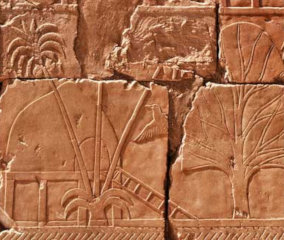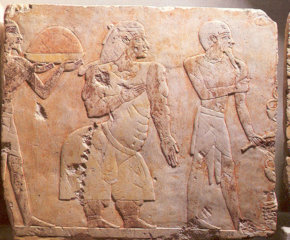The Baboons of Punt
The old adage that "you are what you eat" has been proven true in ways that the inventors of the saying could never have imagined. Scientists have found that our diet throughout life is reflected in various parts of the body. Our hair can show what we ate or drank in the last few days or weeks, a fact that has been used in several cases of arsenic poisoning, where the levels of arsenic in the hair - which varied along its length - were able to pinpoint when the attacker gave the poison to his or her victim.
The composition of our bones covers a much longer period and there the chemical components found in the bones - and particularly readioactive chemicals such as strontium - can point to a particular geographic location.
This is even more the case for teeth, whose enamel is formed very early in the individual's life and remains unchanged throughout the adult life. A few years ago a skeleton was discovered near the Amesbury Circle, not far from Stonehenge. Because of the large number of arrowheads found in the grave the individual was nicknamed "the archer". An analysis of the oxygen isotopes in the man's tooth enamel indicated that he was born in the Alpine region of Europe, leaving to intense speculation on how he came to be buried in England!
A team from Dartmouth College in America has recently used this same technique in an attempt to discover where Punt is located.
Punt, known in ancient Egyptian hieroglyphics as "the god's land", was a significant supplier of luxury goods to the Egyptian market. The most famous record of Punt is to be found on the walls of Deir el-Bahri, the mortuary temple of Queen Hatshepsut in the hills opposite Luxor in Egypt. A series of reliefs depicts the entire voyage, from the loading of the Egyptian ships with trade goods, to their arrival in the Land of Punt.

| |
| A hut in the land of Punt, surrounded by palm trees. |
The reliefs depict clumps of what are obviously palm trees growing around a village of domed huts built on platforms raised on stilts, with a ladder that gives access from the ground to the single door in each hut. The Egyptians are greeted by an enormously fat woman who is depicted with black skin colouring, but whose features are not noticeably negroid.
In Punt the Egyptians exchange their trade goods for gold, incense, trees in pots (the stumps of two of those trees are still in location outside Deir el-Bahri), leopards and leopard skins and live baboons. Other products included gold, ivory, ebony, incense, aromatic resins, eye-makeup cosmetics, fragrant woods, and cinnamon.
Based mainly on these goods, various locations for Punt have been suggested, ranging from southern Arabia to Somalia and as far away as Ceylon. On the whole the evidence seems to point to somewhere in the Horn of Africa. Not only are these various products to be found there, but, as early travellers in Ethiopia discovered, there was a tradition of fattening women in Ethiopia. Girls of high status would be put on a diet rich in milk and cream until they were so fat that they could no longer walk and had to roll along the floor if they wished to move from one part of the hut to another. Ethiopia would also fit with the non-negroid features of the queen of Punt!
A study in 2010 by the University of California analysed hair from two mummified baboons in the British Museum. Only one of the baboons gave clear oxygen isotope results, which means that the sample size was very small. These results were compared with oxygen isotope analysis of modern baboons and were found to match most closely with specimens from Eritrea and Ethiopia rather than Somalia. No baboons from the Yemen were included in the study. A follow-up study in 2015 again pointed to either eastern Somalia or the Eritrea-Ethiopia region.
The 2020 study used tooth enamel and was based on 155 mummified baboons from a number of collections. The majority of the animals came from the New Kingdom period and the Ptolemaic period. Two elements - oxygen and strontium - were measured using isotopic mapping. The results were compared with 155 modern baboons taken from a variety of locations - 77 in all - in eastern Africa and southern Arabia.
The results were somewhat surprising. The majority of New Kingdom baboons had been born in Egypt - and as baboons are not native to Egypt, that points to some sort of captive breeding programme! The same was true of the Ptolemaic baboons.
Just two of the New Kingdom baboons came from outside Egypt and again the results pointed to Eritrea, Ethiopia or northern Somalia. The results also indicate that these two animals must have died shortly after arriving in Egypt because neither tooth enamel nor hair showed any signs of the oxygen isotope signature of Egypt - and as baboons must drink water every day to survive they would surely show the Egyptian signature if they had drunk Egyptian water for more than a few weeks.

| |
| The grossly corpulent queen of Punt |
Valikovsky and others have suggested that Punt, "the god's land", is really Palestine and proposed that Hatshepsut was the "Queen of Sheba" who visited Solomon. Velikovsky in particular is quite ingenious in the way he seeks to harmonise the pictures from Deir el-Bahri with what might be expected in Jerusalem, even if the figure of the queen of Punt is hardly complimentary to Solomon's taste in women!
These latest results seem to disprove that hypothesis. That is not to say that Hatshepsut may not have visited Palestine at some time, but we can be fairly certain that she did not confuse the court of Solomon with the native huts of Punt, the land from which baboons came.
© Kendall K. Down 2020





